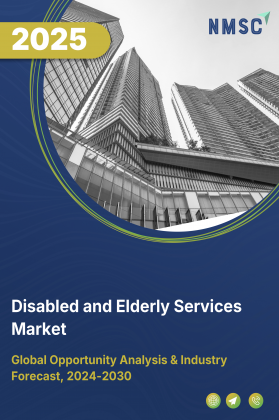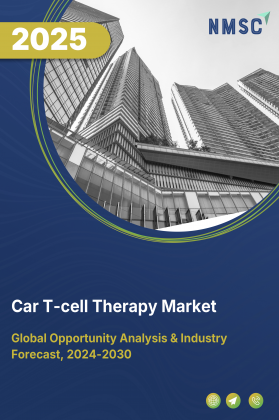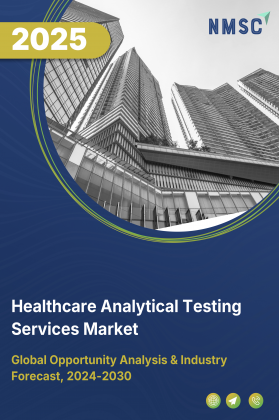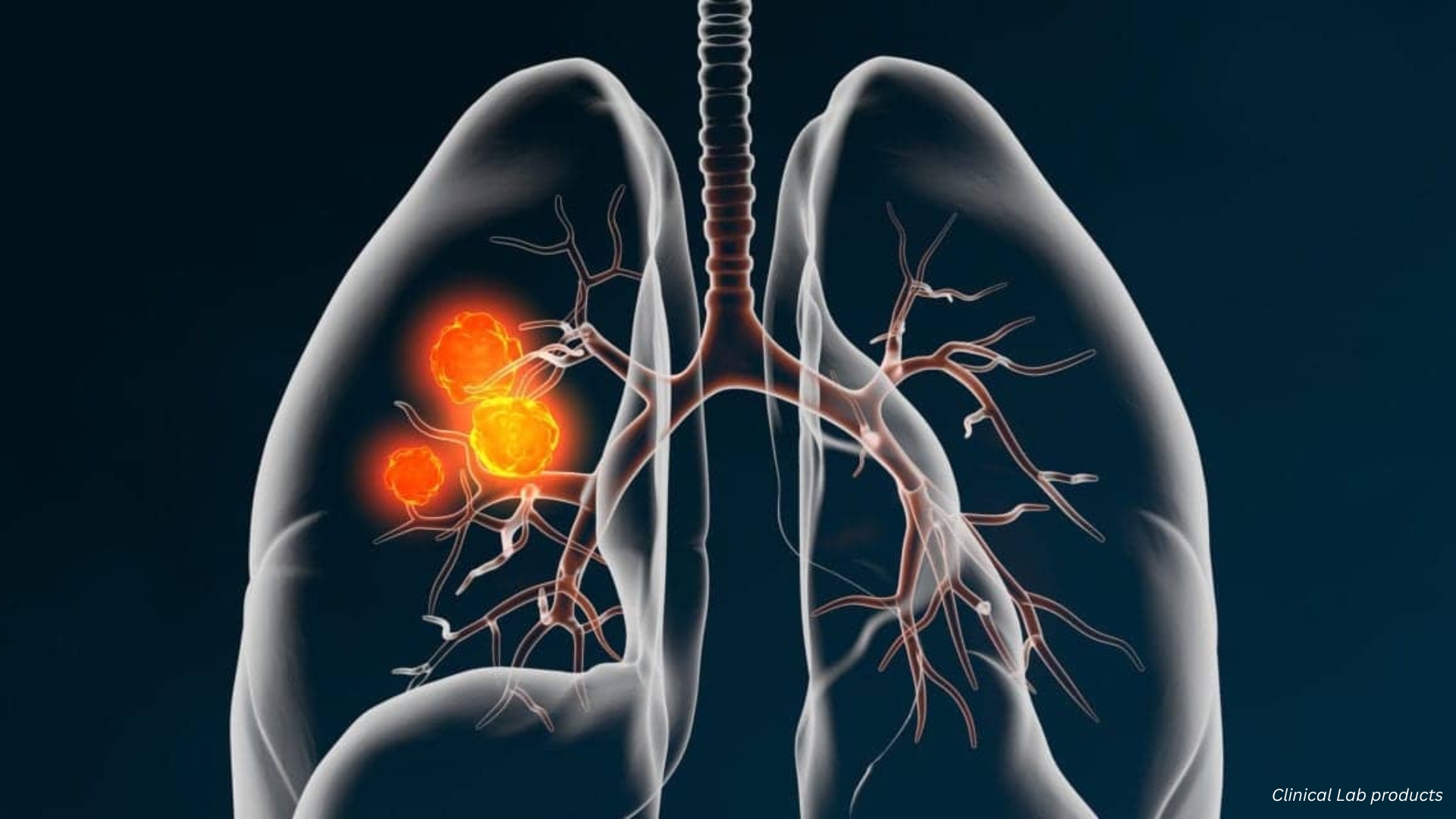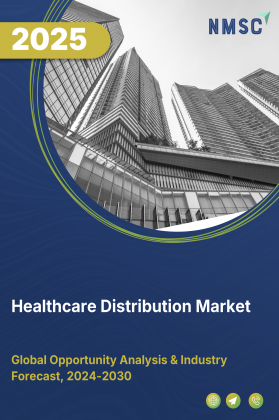
Healthcare Distribution Market by Product Type (Pharmaceuticals, Medical Devices and Equipment, Biologics and Advanced Therapies), by Service Type (Inventory, Temperature Management, Customization, Compliance, Reverse Logistics, Data Solutions), by Distribution Model (Wholesale Channels, Direct Channels, Technology-Enabled Models, Last-Mile Delivery), and by End-User (Retail Pharmacy, Home-Based Care Providers) – Global Opportunity Analysis and Industry Forecast, 2025–2030.
Industry Overview
The global Healthcare Distribution Market size was valued at USD 1265.77 billion in 2024, and is expected to be valued at USD 1369.56 billion by the end of 2025. The industry is projected to grow, hitting USD 2031.04 billion by 2030, with a CAGR of 8.2% between 2025 and 2030.
The market is experiencing robust growth, fueled by the rising demand for efficient drug delivery systems, diagnostic tools, and the integration of advanced technologies like artificial intelligence (AI). Innovations in distribution models are streamlining supply chains, enhancing the timely and accurate delivery of pharmaceuticals, and improving access to personalized treatments.
AI is playing a transformative role by optimizing inventory management, predicting demand, and improving patient care logistics. While challenges such as regulatory complexities, cost pressures, and data privacy concerns persist, the sector holds significant promise. With increasing emphasis on precision medicine and value-based care, the market is set to become a critical enabler of more effective, patient-centric healthcare delivery.
Rising Demand for Pharmaceuticals and Chronic Disease Treatments
The increasing prevalence of chronic diseases worldwide is significantly driving sales in the healthcare distribution market growth. In particular, conditions such as cancer, diabetes, and cardiovascular diseases require consistent access to medications, creating strong and sustained demand for pharmaceutical distribution channels.
According to the Centers for Disease Control and Prevention (CDC), chronic diseases like heart disease, cancer, and diabetes are the leading causes of death and disability in the United States. These illnesses are also responsible for the bulk of the nation’s $4.9 trillion in annual healthcare costs. The scale of this health burden is substantial—6 in 10 Americans live with at least one chronic disease, and 4 in 10 suffer from two or more.
This growing patient base is heavily reliant on a steady supply of medications, specialty therapies, and diagnostic products, leading hospitals, pharmacies, and clinics to depend on efficient healthcare distribution systems. Moreover, advancements in treatment protocols and long-term disease management have increased the need for timely, temperature-controlled, and secure delivery of complex drugs, further boosting the role and sales of distributors in this sector.
In essence, as chronic disease rates continue to climb, particularly in aging populations across developed and developing countries, the healthcare distribution remains a critical backbone for ensuring uninterrupted access to life-sustaining treatments.
Increased Government Investment in Healthcare Infrastructure Boost the Market Growth
Government spending continues to play a crucial role in accelerating the healthcare distribution market demand. With rising public demand for accessible and affordable healthcare services, countries are expanding investments in public health systems, pharmaceuticals, and medical logistics.
In India, for example, the central government has allocated USD 11.5 billion to the healthcare sector for FY26, reflecting a 9.46% increase over the FY25 budget estimates. This uptick underscores a continued commitment to strengthening the sector, especially in areas such as disease prevention, primary healthcare centers, diagnostics, and the National Health Mission.
However, despite the increase, analysts note that this allocation still falls short of bridging the long-standing resource gap in public health infrastructure, which limits the capacity to deliver high-quality and equitable care nationwide. Nonetheless, the budget expansion fuels demand for pharmaceuticals, vaccines, and medical equipment, thereby creating consistent opportunities for healthcare distributors—especially in the public procurement segment.
As developing countries like India continue scaling up their healthcare budgets, the demand for efficient, large-scale distribution networks is expected to grow, making government investment a key sales driver in this market.
Surge in E-commerce and Digital Healthcare Platforms Creates Market Expansion
The rapid growth of e-commerce and digital healthcare platforms is transforming the healthcare distribution landscape by making the delivery of medical products faster, more accessible, and highly efficient. The integration of digital technologies is streamlining supply chains, minimizing delivery lead times, and improving inventory management across the sector. Companies are increasingly investing in real-time inventory tracking systems, AI-driven demand forecasting, and automated fulfillment centers to enhance operational efficiency and reduce stockouts.
Additionally, the emergence of direct-to-consumer (D2C) models, especially for over-the-counter drugs, wellness products, and chronic care medication refills, is reshaping how healthcare products reach end users. Telemedicine platforms, online pharmacies, and app-based diagnostic services are also contributing to higher volumes of distributed healthcare products, particularly in urban and semi-urban regions.
This digital shift not only enables better responsiveness to market demands but also opens new sales channels for distributors, especially in underserved areas where physical pharmacy access may be limited. As consumers increasingly embrace online health solutions, the role of tech-enabled distribution is expected to expand further, becoming a key revenue driver in the market.
Complex Regulatory Environment and Compliance Challenges Hinders the Market Growth
One of the major restraints facing the market is the complex and constantly evolving regulatory landscape across different countries. Healthcare distributors must adhere to strict guidelines related to drug storage, transportation, labeling, import/export protocols, and temperature-sensitive logistics, especially for biologics and controlled substances.
Regulatory bodies such as the FDA (U.S.), EMA (Europe), and CDSCO (India) impose stringent compliance requirements that can vary by product type, geography, and distribution model. These regulatory complexities can hinder market entry, slow down expansion plans, and limit the overall agility of distribution networks ultimately acting as a barrier to growth in the global healthcare distribution sector.
IoT-Enabled Smart Logistics Creates Future Opportunity for the Market
The integration of Internet of Things (IoT) technology is emerging as a transformative force in the healthcare distribution, offering a powerful solution to existing challenges in supply chain visibility and regulatory compliance. IoT-enabled sensors and smart tracking devices allow real-time monitoring of critical parameters such as temperature, humidity, shock, and location, which is especially crucial for biologics, vaccines, and other temperature-sensitive drugs. This technology ensures product integrity from warehouse to delivery, reduces spoilage, and helps meet strict global compliance standards.
As the demand for complex therapies and precision medicines grows, IoT adoption is expected to surge, providing healthcare distributors with a critical opportunity to modernize operations, lower risk, and build trust with regulatory bodies and clients. This shift toward smart logistics will be a key driver of future growth and competitive advantage in the global industry.
Market Segmentation and Scope of the Study
The healthcare distribution market report is segmented by product type, service type, distribution model, and end user. On the basis of product type, the market is classified into pharmaceuticals, medical devices and equipment, and biologics and advanced therapies. Based on distribution model, it is segmented into wholesale channels, direct channels, technology-enabled models, and last-mile delivery. In terms of end user, the market includes retail pharmacy, hospitals and health systems, home-based care providers and others.
Geographical Analysis
The growth of the market in North America is primarily driven by rising demand for medical products due to an aging population, increasing chronic disease cases, and expanding access to healthcare. The region is witnessing a significant shift toward specialty and biologic drugs, which require advanced cold-chain logistics and precise handling.
Distributors are investing heavily in digital technologies such as AI, blockchain, and IoT to streamline supply chains, ensure regulatory compliance and enhance delivery efficiency. Moreover, the growing popularity of e-commerce in healthcare through online pharmacies and telehealth platforms—has fueled demand for direct-to-consumer prescription delivery and localized micro-fulfillment centers.
Major players like McKesson, Cencora, and Cardinal Health continue to dominate the healthcare distribution market share, leveraging vertical integration, data analytics, and acquisitions to expand their reach. Additionally, environmental and regulatory pressures are pushing companies to adopt greener logistics and more traceable, secure systems, further strengthening North America’s leadership in the global healthcare distribution landscape.
The market in Europe is driven by a combination of stringent regulatory frameworks, rising demand for specialty pharmaceuticals, and investments in advanced logistics infrastructure. The European Union enforces rigorous compliance standards such as the GDP guidelines and the Falsified Medicines Directive, which have compelled distributors to adopt high-quality warehousing, packaging, and tracking systems.
Countries like Germany, France, and the UK are leading the charge with well-established healthcare systems and increasing consumption of high-value biologics and temperature-sensitive drugs. The growing focus on reducing counterfeit medicines has accelerated the adoption of serialization, digital inventory management, and secure labeling technologies.
Moreover, the expansion of public health programs and aging populations across Europe are contributing to consistent pharmaceutical demand. Strategic collaborations between manufacturers and third-party logistics providers (3PLs) are also helping optimize cross-border distribution, especially in Eastern and Central Europe.
As Europe moves toward sustainability goals, many distributors are shifting to eco-friendly packaging and electrified transport fleets, further enhancing their competitive advantage in the evolving healthcare supply chain ecosystem.
The market in Asia-Pacific (APAC) is witnessing robust growth, fueled by expanding healthcare access, rising chronic disease prevalence, and increasing government investments in public health infrastructure. Rapid urbanization and growing middle-class populations in countries like China, India, Indonesia, and Vietnam are driving higher demand for pharmaceutical and medical device distribution.
The region is also experiencing a surge in demand for cold-chain logistics due to the rising use of vaccines, biologics, and temperature-sensitive drugs. Local distributors are forming strategic alliances with global logistics providers to enhance last-mile delivery and reach underserved rural areas.
Additionally, the adoption of digital platforms, e-pharmacies, and telemedicine is transforming distribution channels, particularly in tech-forward markets like South Korea and Singapore. With favorable regulatory reforms and growing foreign investments, APAC continues to emerge as a key region for healthcare supply chain expansion and innovation.
The Rest of the World (RoW) market, covering Latin America, the Middle East, and Africa, is growing due to improving healthcare infrastructure, rising government spending, and expanding access to essential medicines. Countries like Brazil, Mexico, and the UAE are investing in health systems, while Africa benefits from global partnerships to improve supply chains and reduce counterfeit drugs. Though challenges like weak logistics and regulatory gaps remain, the rise of e-pharmacies, telemedicine, and mHealth solutions is enhancing reach and driving long-term growth potential in the region.
Key Players and Their Strategies in the Global Healthcare Distribution Industry
Various players in the industry are leading and adopting various strategies. These market players are opting strategies such as business expansions and collaborations to maintain their dominance and competitiveness in the market.
-
In June 2025, Cardinal Health launched the Kendall DL Multi System in the U.S., a single-patient monitoring device that tracks vital signs through one connection from admission to discharge. This highlights the rising demand for advanced, high-value medical technologies in healthcare distribution, emphasizing the need for efficient and reliable supply chains to support modern patient care
-
In April 2025, Owens & Minor, Inc. announced key advancements in its Products & Healthcare Services (P&HS) segment, aimed at enhancing medical distribution through investments in technology, automation, and analytics. These upgrades, beginning with two new distribution centers in West Virginia and South Dakota, reflect the company's focus on improving operational efficiency and customer experience. This moves underscores the growing importance of digital transformation and infrastructure expansion in strengthening healthcare distribution networks.
Key Benefits
-
The report provides quantitative analysis and estimations of the industry from 2025 to 2030, which assists in identifying the prevailing market opportunities.
-
The study comprises a deep dive analysis of the current and future healthcare distribution market trends to depict prevalent investment pockets in the sector.
-
Information related to key drivers, restraints, and opportunities and their impact on the industry is provided in the report.
-
Competitive analysis of the players, along with their market share, is provided in the report.
-
SWOT analysis and Porter's Five Forces model are elaborated in the study.
-
Value chain analysis in the market study provides a clear picture of the roles of stakeholders.
Healthcare Distribution Market Key Segments
By Product Category
-
Pharmaceuticals
-
Branded Prescription Drugs
-
Generic Drugs
-
OTC & Wellness Products
-
Clinical Trial Materials
-
-
Medical Devices & Equipment
-
Implantable Devices
-
Diagnostic Equipment
-
Disposable Medical Supplies
-
-
Biologics & Advanced Therapies
-
Vaccines
-
Cell & Gene Therapies
-
By Service Type
-
Inventory Services
-
Vendor-Managed Inventory
-
Consignment Stock Programs
-
-
Temperature Management
-
Cold Chain Storage
-
Cryogenic Shipping
-
-
Product Customization
-
Clinical Procedure Kits
-
Patient-Specific Packaging
-
-
Compliance Services
-
Serialization Implementation
-
Regulatory Documentation
-
-
Reverse Logistics
-
Recall Management
-
Expired Product Returns
-
-
Data Solutions
-
Demand Forecasting
-
Supply Chain Analytics
-
By Distribution Model
-
Wholesale Channels
-
Full-Line Distributors
-
Specialty Distributors
-
-
Direct Channels
-
Manufacturer-Owned Distribution
-
Contract Logistics Providers
-
-
Technology-Enabled Models
-
Digital Procurement Platforms
-
Blockchain-Based Tracking Systems
-
-
Last-Mile Delivery
-
Patient-Specific Shipping
-
Localized Fulfillment Nodes
-
By End Customer
-
Institutional Care
-
Hospitals & Health Systems
-
Surgical Centers & Clinics
-
-
Retail Pharmacy
-
Chain Pharmacies
-
Independent Drugstores
-
-
Home-Based Care Providers
-
Government and Public Health Agencies
By Region
-
North America
-
The U.S.
-
Canada
-
Mexico
-
-
Europe
-
The UK
-
Germany
-
France
-
Italy
-
Spain
-
Denmark
-
Netherlands
-
Finland
-
Sweden
-
Norway
-
Russia
-
Rest of Europe
-
-
Asia-Pacific
-
China
-
Japan
-
India
-
South Korea
-
Australia
-
Indonesia
-
Singapore
-
Taiwan
-
Thailand
-
Rest of Asia-Pacific
-
-
RoW
-
Latin America
-
Middle East
-
Africa
-
Key Players
-
AmerisourceBergen Corporation (Cencora)
-
Cardinal Health, Inc.
-
Henry Schein Inc.
-
Smith Drug Company
-
FFF Enterprises
-
Patterson Companies Inc.
-
Mutual Drug
-
Medline Industries
-
PHOENIX Group
-
Anda, Inc.
-
Dakota Drug, Inc
-
Auburn Pharmaceutical
-
Pharmox LLC
REPORT SCOPE AND SEGMENTATION:
|
Parameters |
Details |
|
Market Size in 2025 |
USD 1369.56 Billion |
|
Revenue Forecast in 2030 |
USD 2031.04 Billion |
|
Growth Rate |
CAGR of 8.2% from 2025 to 2030 |
|
Analysis Period |
2024–2030 |
|
Base Year Considered |
2024 |
|
Forecast Period |
2025–2030 |
|
Market Size Estimation |
Billion (USD) |
|
Growth Factors |
|
|
Countries Covered |
28 |
|
Companies Profiled |
15 |
|
Market Share |
Available for 10 companies |
|
Customization Scope |
Free customization (equivalent up to 80 working hours of analysts) after purchase. Addition or alteration to country, regional, and segment scope. |
|
Pricing and Purchase Options |
Avail customized purchase options to meet your exact research needs. |

















 Speak to Our Analyst
Speak to Our Analyst



